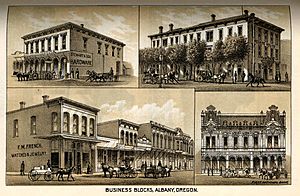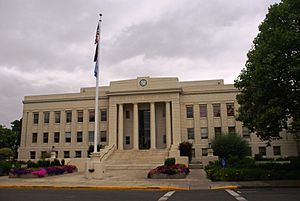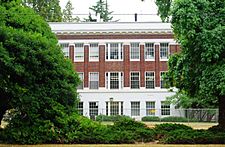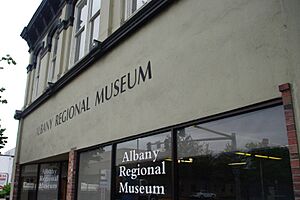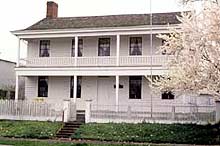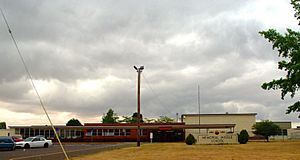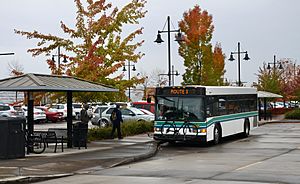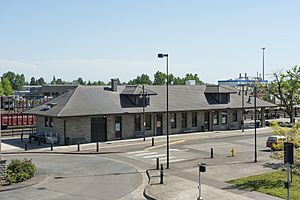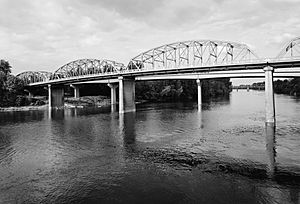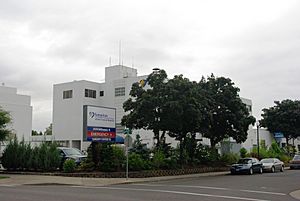Albany, Oregon facts for kids
Quick facts for kids
Albany, Oregon
|
|||
|---|---|---|---|

Looking west down 1st Avenue SW in downtown Albany
|
|||
|
|||
| Nickname(s):
Hub of the Valley Grass Seed Capital Rare Metals Capital
|
|||
| Motto(s):
The center of the Willamette Valley; the heart of Oregon
|
|||

Location in Oregon
|
|||
| Country | United States | ||
| State | Oregon | ||
| Counties | Linn, Benton | ||
| Incorporated | 1864 | ||
| Government | |||
| • Type | Council-Manager | ||
| Area | |||
| • City | 17.87 sq mi (46.27 km2) | ||
| • Land | 17.66 sq mi (45.73 km2) | ||
| • Water | 0.21 sq mi (0.54 km2) | ||
| • Urban | 21.7 sq mi (56 km2) | ||
| Elevation | 226 ft (69 m) | ||
| Population
(2020)
|
|||
| • City | 56,472 | ||
| • Density | 3,198.10/sq mi (1,234.81/km2) | ||
| • Urban | 62,074(US: 439th) | ||
| • Metro | 128,610 (US: 315th) | ||
| Time zone | UTC−8 (Pacific) | ||
| • Summer (DST) | UTC−7 (Pacific) | ||
| ZIP codes |
97321-97322
|
||
| Area codes | 541, 458 | ||
| FIPS code | 41-01000 | ||
| GNIS feature ID | 2409675 | ||
Albany (/ˈælbəni/ al-BƏ-nee) is a city in Oregon, located in the Willamette Valley. It's the main city for Linn County and is the 11th largest city in the state. Albany sits where the Calapooia River meets the Willamette River. Parts of the city are in both Linn and Benton counties.
This city is mostly known for farming and manufacturing. Settlers first started the town around 1848. In 2020, about 56,472 people lived in Albany.
Albany has a special type of local government called a council–manager government. This means a city council makes decisions, and a city manager handles daily operations. The city offers many fun things to do, like over 30 parks and trails, a senior center, and cultural events. Some popular events include the Northwest Art and Air Festival, River Rhythms, and Movies at Monteith. Besides farming and manufacturing, Albany's economy also relies on shopping, healthcare, and social services. The city has been working to make its downtown area a lively place to shop again.
Contents
- Discover Albany's Past: A Journey Through Time
- Albany's Location and Weather
- Who Lives in Albany?
- What Drives Albany's Economy?
- Fun Things to Do in Albany
- Parks and Outdoor Fun
- Learning and Schools in Albany
- News and Radio in Albany
- Getting Around Albany
- Notable People from Albany
- Images for kids
- See also
Discover Albany's Past: A Journey Through Time
How Albany Got Started
Long ago, the area where Albany is now was home to the Kalapuya people. They were a Native American group who spoke a language called Penutian. They called this place Takenah, which described the deep pool where the Calapooia and Willamette rivers meet.
Sadly, many Kalapuya people died from new diseases like smallpox and malaria that arrived with Europeans. It's thought that up to 90% of the Kalapuya population was lost. Later, they signed treaties to give up their land, which opened the way for European Americans to settle.
The first European American settler, Abner Hackleman, arrived in 1845. He claimed land for himself. In 1847, two brothers, Walter and Thomas Monteith, came to the area after traveling the Oregon Trail. In 1848, they bought 320 acres (1.3 km²) of land. They planned out 60 acres (0.24 km²) for a town and named it "Albany" after their hometown in New York. Around the same time, Hackleman's son, Abram, built a log house on his father's land. This area was known as Takenah in 1849.
The Monteith and Hackleman families had different ideas about how the town should be. The Monteiths' part of town had mostly merchants and professionals who supported the Union during the Civil War. The Hacklemans' side had working-class people who were split on the war. They even planted a hedge to separate their parts of town!
In 1849, the Monteith brothers built the first frame house in Albany, known as the Monteith House. It was considered one of the best houses in Oregon back then. They also used money from the California Gold Rush to start new businesses, making Albany an important center in the Willamette Valley.
Growing as a Community
Albany's first school opened in 1851. The first teacher was Eleanor B. Hackleman. A building just for the school was built in 1855. In 1852, the first steamboat, the Multnomah, arrived, and the first flour mill was built.
A U.S. post office was set up in Albany on January 8, 1850. The town was briefly called "New Albany" but changed back to Albany in 1853. In 1851, Albany became the county seat for Linn County. The first Albany courthouse was built in 1852 on land given by the Monteiths. This made sure Albany stayed the county seat.
For a short time, some people tried to rename the town "Takenah" again. But because "Takenah" was sometimes wrongly translated as "Hole in the Ground," the name "Albany" was brought back in 1855. Finally, in 1864, Albany officially became a city.
Trains and Industry Arrive
In 1871, trains reached Albany, connecting it to other towns. This was a huge event for the city! Local business owners raised money to make sure the train tracks came through Albany. Trains made it easier for farmers to sell their goods. In 1888, the world's longest wooden railroad drawbridge was built for the Albany-Corvallis route. By 1910, 28 passenger trains left Albany every day.
In 1872, a canal was built from the Santiam River, bringing water to Albany. This canal helped power businesses. In 1924, Pacific Power used the canal to generate electricity. The city later bought the water system and reopened the hydroelectric plant in 2009.
Albany in the 20th Century
In the 1940s, Albany hosted the Albany World Championship Timber Carnival. This event brought loggers from all over the world to compete in logging skills. It was a big celebration over the Fourth of July weekend. However, due to smaller crowds and a decline in the timber industry, the carnival was canceled in 2001.
The U.S. Bureau of Mines opened the Albany Research Center (ARC) in 1942. This center focused on creating new ways to work with metals. It became known for producing special metals like titanium and zirconium. This led to a new "rare metals" industry in Albany. Companies like Wah Chang became famous for this work. In 1996, the ARC became part of the United States Department of Energy.
Albany's Location and Weather
Where is Albany Located?
Albany is in the middle of Oregon's most populated area, the Willamette Valley. It's right where the Calapooia and Willamette rivers meet. Most of Albany is in Linn County, but a small part is across the Willamette River in Benton County.
The city covers about 17.75 square miles (45.97 km²). Most of this is land, with a small amount of water. Albany is one of the lowest points in the Willamette Valley, with elevations from 180 to 430 feet (55 to 131 m) above sea level. The North Albany area has more hills, while downtown and the southern part of town are mostly flat.
 |
Salem | Jefferson |  |
|
| Corvallis | Tangent | Lebanon |
What is Albany's Climate Like?
Albany has mild weather, like most of Western Oregon. Summers are generally warm and dry. The least rain falls in July, and temperatures reach an average of 80.8°F (27.1°C) in August. The hottest temperature ever recorded in Albany was 110°F (43°C) in June 2021.
Winters are cool and wet. December is the wettest month, with about 6.8 inches (170 mm) of rain. January is the coldest month, with an average low temperature just above freezing at 33.6°F (0.9°C). The coldest temperature ever recorded was -7°F (-22°C) in 1972.
Albany was also hit hard by the Columbus Day Storm in October 1962.
| Climate data for Albany, Oregon | |||||||||||||
|---|---|---|---|---|---|---|---|---|---|---|---|---|---|
| Month | Jan | Feb | Mar | Apr | May | Jun | Jul | Aug | Sep | Oct | Nov | Dec | Year |
| Record high °F (°C) | 68 (20) |
71 (22) |
81 (27) |
91 (33) |
95 (35) |
111 (44) |
106 (41) |
106 (41) |
100 (38) |
90 (32) |
73 (23) |
65 (18) |
111 (44) |
| Mean maximum °F (°C) | 57.7 (14.3) |
61.6 (16.4) |
69.8 (21.0) |
78.7 (25.9) |
86.0 (30.0) |
90.9 (32.7) |
95.9 (35.5) |
95.1 (35.1) |
90.4 (32.4) |
78.5 (25.8) |
64.3 (17.9) |
58.6 (14.8) |
101.8 (38.8) |
| Mean daily maximum °F (°C) | 46.2 (7.9) |
50.2 (10.1) |
56.5 (13.6) |
60.2 (15.7) |
68.4 (20.2) |
73.7 (23.2) |
82.6 (28.1) |
83.1 (28.4) |
75.8 (24.3) |
64.7 (18.2) |
53.5 (11.9) |
46.5 (8.1) |
63.5 (17.5) |
| Daily mean °F (°C) | 39.9 (4.4) |
42.3 (5.7) |
46.7 (8.2) |
50.4 (10.2) |
56.7 (13.7) |
61.5 (16.4) |
67.9 (19.9) |
67.9 (19.9) |
61.8 (16.6) |
53.6 (12.0) |
45.7 (7.6) |
40.7 (4.8) |
52.9 (11.6) |
| Mean daily minimum °F (°C) | 33.6 (0.9) |
34.4 (1.3) |
36.9 (2.7) |
40.5 (4.7) |
44.9 (7.2) |
49.3 (9.6) |
53.2 (11.8) |
52.6 (11.4) |
47.8 (8.8) |
42.4 (5.8) |
37.8 (3.2) |
34.9 (1.6) |
42.4 (5.8) |
| Mean minimum °F (°C) | 22.6 (−5.2) |
24.4 (−4.2) |
28.3 (−2.1) |
31.8 (−0.1) |
34.7 (1.5) |
40.6 (4.8) |
44.9 (7.2) |
44.8 (7.1) |
38.7 (3.7) |
31.2 (−0.4) |
26.2 (−3.2) |
21.6 (−5.8) |
16.9 (−8.4) |
| Record low °F (°C) | −3 (−19) |
−4 (−20) |
13 (−11) |
24 (−4) |
29 (−2) |
30 (−1) |
38 (3) |
36 (2) |
29 (−2) |
21 (−6) |
10 (−12) |
−8 (−22) |
−8 (−22) |
| Average precipitation inches (mm) | 6.16 (156) |
4.98 (126) |
4.36 (111) |
2.49 (63) |
2.17 (55) |
1.33 (34) |
0.39 (9.9) |
0.50 (13) |
1.72 (44) |
3.38 (86) |
6.10 (155) |
6.31 (160) |
39.89 (1,012.9) |
| Average snowfall inches (cm) | 2.4 (6.1) |
1.2 (3.0) |
0.4 (1.0) |
0.1 (0.25) |
0.0 (0.0) |
0.0 (0.0) |
0.0 (0.0) |
0.0 (0.0) |
0.0 (0.0) |
0.0 (0.0) |
0.2 (0.51) |
1.2 (3.0) |
5.5 (13.86) |
| Average precipitation days | 19 | 17 | 17 | 14 | 12 | 8 | 2 | 3 | 7 | 12 | 17 | 19 | 147 |
| Source: WRCC | |||||||||||||
Who Lives in Albany?
| Historical population | |||
|---|---|---|---|
| Census | Pop. | %± | |
| 1870 | 1,292 | — | |
| 1880 | 1,867 | 44.5% | |
| 1890 | 3,079 | 64.9% | |
| 1900 | 3,149 | 2.3% | |
| 1910 | 4,275 | 35.8% | |
| 1920 | 4,840 | 13.2% | |
| 1930 | 5,325 | 10.0% | |
| 1940 | 5,654 | 6.2% | |
| 1950 | 10,115 | 78.9% | |
| 1960 | 12,926 | 27.8% | |
| 1970 | 18,181 | 40.7% | |
| 1980 | 26,546 | 46.0% | |
| 1990 | 29,462 | 11.0% | |
| 2000 | 40,852 | 38.7% | |
| 2010 | 50,158 | 22.8% | |
| 2020 | 56,472 | 12.6% | |
| Source: U.S. Decennial Census 2018 Estimate |
|||
Population Facts from 2020
In 2020, Albany had 56,472 people. Most residents (79.5%) were White. Other groups included African American (0.8%), American Indian or Alaska Native (1.4%), and Asian (1.8%). About 14.1% of the population was Hispanic or Latino.
There were 22,157 households. About 17.5% of these had children under 18. Many households (46.2%) were married couples. The average age in Albany was 37.8 years old. About 22.3% of the people were under 18, and 18.0% were 65 or older. The city had slightly more females (51.3%) than males (48.7%).
What Drives Albany's Economy?
Albany is known as the "rare metals capital of the world." It produces special metals like zirconium, hafnium, and titanium. One of the main companies making these metals is ATI Specialty Alloys and Components (formerly ATI Wah Chang).
The area around Albany is also a big exporter of grass seed. Other important crops grown here include corn, beans, mint, strawberries, and hazelnuts. Because of this, Linn County is also called the "Grass Seed Capital of the World."
Even though the timber industry has declined, Albany has a strong and varied economy. The main parts of its economy are retail (shopping), healthcare, social services, and manufacturing. Oregon Freeze Dry is a major employer in manufacturing. They make freeze-dried foods and have their main research and development center in Albany. Another company, Tec Laboratories, makes medicines like Tecnu poison ivy cleanser.
The Albany Research Center (ARC) is also a key part of the economy. It's now part of the National Energy Technology Laboratory (NETL). The ARC focuses on researching and developing new metals, alloys, and ceramics. It also works on recycling and cleaning up waste from these processes.
Fun Things to Do in Albany
Yearly Events and Festivals
Albany hosts many exciting events throughout the year. These include:
- The Northwest Art and Air Festival, where you can see amazing art and hot air balloons.
- River Rhythms and Summer Sounds, which are outdoor music events.
- The Veteran's Day Parade, honoring those who served.
- The Albany Upstairs Downtown Wine Walk.
- The Craft Brew Smackdown.
The popular Albany Timber Carnival ended in 2000, and an attempt to bring it back in 2008 wasn't successful. The Albany Arts Festival also used to be held here from 1970 to the late 1980s.
Museums and Interesting Places to Visit
There are many interesting places to explore in Albany:
- The Thomas and Walter Monteith House is one of the oldest buildings in Albany. It's now a museum and is listed on the National Register of Historic Places.
- Whitespires Church is another historic building and the tallest in town.
- The Albany Regional Museum teaches you about Albany's history. It's in a historic building from 1887.
- Downtown Albany is a National Historic District. It has antique shops, restaurants, and the Albany Civic Theater, which has been putting on plays since 1951. You can also find one of the oldest Carnegie libraries still used as a library.
- A hand-carved carousel has been under construction at the Albany Historic Carousel and Museum since the early 2000s.
Albany has four historic districts: the Albany Municipal Airport, Monteith Historic District, Hackleman Historic District, and the Albany Downtown Commercial Historic District. These areas show off many different house styles from 1840 to 1920. There are over 700 historic buildings in these districts!
Parks and Outdoor Fun
The Albany Parks and Recreation Department takes care of the city's parks, trails, and recreation programs. They manage the Senior Center, the Periwinkle Creek Bike Path, and other outdoor spaces. They also organize summer events like River Rhythms and the Northwest Art & Air Festival. The department aims for everyone in Albany to live within 2 miles (3.2 km) of a park.
Timber-Linn Memorial Park has the 63rd Blue Star veterans memorial in Oregon. This memorial honors Linn County service members who died in 20th-century wars. In 2009, Timber-Linn Memorial Park also hosted the American Veterans Traveling Tribute, a traveling replica of the Vietnam Memorial wall.
Albany also has a special urban forestry program. This includes the Legacy Forest at Lexington Park, where people can plant trees to remember individuals or groups. The city is part of the Tree City USA program and celebrates Arbor Week every year.
For sports lovers, Albany has two golf courses in North Albany: The Golf Club of Oregon and Spring Hill Golf Club. There's also a bowling alley, Lake Shore Lanes, which has a miniature golf course.
Learning and Schools in Albany
Albany is home to the main campus of Linn-Benton Community College, a two-year college started in 1966. It offers various programs and helps students transfer to bigger universities like Oregon State University.
The Greater Albany Public School District serves the area. It includes West Albany High School and South Albany High School, which together have about 2,700 students. The district also has Albany Options School, an alternative school for grades 6-12. In total, the district serves about 8,900 students across 23 different schools. There's also Maple Lawn Preschool for younger children.
| Name | Current campus | Enrollment (2009–10) | Nickname |
|---|---|---|---|
| South Albany High School | 1970 | 1,270 | RedHawks |
| West Albany High School | 1953 | 1,450 | Bulldogs |
| Albany Options School | 2001 | 155 | Knights |
A college called Albany Collegiate Institute was founded in Albany in 1867. After 70 years, it moved to Portland and became Lewis & Clark College.
News and Radio in Albany
Local Newspaper
Albany's main newspaper is the daily Albany Democrat-Herald. It's owned by Lee Enterprises. The newspaper started as the Albany Democrat in 1859. Lee Enterprises also publishes the Mid-Valley Times, which is the Sunday version of the paper.
Radio Stations
Albany has several radio stations that broadcast from or have offices in the city.
- FM Stations:
* 107.9 FM KHPE (HOPE-FM) plays Christian contemporary music. * 99.9 FM KRKT-FM plays country music. * 101.5 FM KFLY is based in Eugene, Oregon, but has an office in Albany.
- AM Stations:
* 790 AM KWIL is the AM version of KHPE. * KSHO (920 AM) plays adult standard music. * KTHH (990 AM) plays comedy and broadcasts Seattle Mariners baseball games. * KEJO (1240 AM) is a sports radio station. * KGAL (1580 AM) is the local news and talk radio station.
Getting Around Albany
Roads and Highways
Albany is right next to Interstate 5, a major highway. Oregon Route 99E runs north and south through the city, and U.S. Route 20 runs east and west. Just south of Albany, Oregon Route 34 also runs east to west.
Air Travel
The Albany Municipal Airport is a general aviation airport on the east side of Albany. It opened in 1920 and is believed to be the oldest operating airfield in Oregon. In 1998, it became the first airport in Oregon to be listed on the National Register of Historic Places. The airport hosts air shows and Young Eagles flights for children as part of the Northwest Art & Air Festival. It has one asphalt runway. For commercial flights, the closest airports are Eugene Airport to the south and Portland International Airport to the north.
Bus Services
The Albany Transit System (ATS) provides public transportation within Albany. You can also take a bus to Corvallis using the Linn-Benton Loop and Valley Retriever systems. All these bus services connect to the Amtrak station.
Train Travel
Amtrak, the national passenger train system, serves Albany at its Albany Station.
- The Coast Starlight train, which travels from Los Angeles to Seattle, stops in Albany daily.
- The Amtrak Cascades commuter trains run between Vancouver, British Columbia and Eugene, Oregon, stopping in Albany several times a day. This line is part of a proposed high-speed rail project.
The Albany train station was built in 1909 for the Southern Pacific Railroad. It's one of the oldest continuously operating passenger train stations in the U.S. The station and the area around it were renovated in 2004.
Bridges
Albany has two important bridges: the Ellsworth Street Bridge (built in 1926) and the Lyon Street Bridge (built in 1973). Both are two-lane bridges that are part of U.S. Route 20. They connect Linn County to Benton County by crossing the Willamette River, linking downtown Albany with the north side of town and Corvallis.
Paths and Trails
Albany has many paths and trails for walking and biking.
- Simpson Park Trail is a dirt trail about 2.36 miles (3.8 km) round trip.
- Periwinkle Creek Trail is the longest paved trail, about 3.61 miles (5.8 km) round trip. It runs along Periwinkle Creek.
- Other trails include Cox Creek Loop, Waverly Lake Loop, Dave Clark Trail, Oak Creek Greenbelt Trail, Takena Landing Trail, and Timber Linn Park Trails. There's also a planned path to connect Swanson Park with the Amtrak/Transit Center.
Albany is working to become more bicycle-friendly. The city was recognized as a Bicycle-Friendly Community in 2010 by the League of American Bicyclists.
Notable People from Albany
- Jerry Andrus (1918–2007) – a famous magician.
- Mike Barrett (born 1968) – a TV announcer for the NBA.
- George Earle Chamberlain (1854–1928) – the 11th Governor of Oregon.
- Daveigh Chase (born 1990) – an actress.
- Abigail Scott Duniway (1834–1915) – a writer and advocate for women's rights.
- Dave Johnson (born 1963) – an Olympic athlete and former high school teacher.
- Sam Shoen (1916–1999) – the founder of U-Haul Corp.
Images for kids
See also
 In Spanish: Albany (Oregón) para niños
In Spanish: Albany (Oregón) para niños






